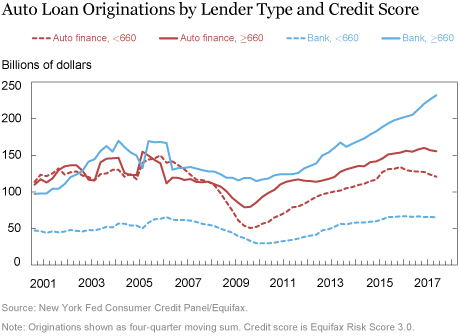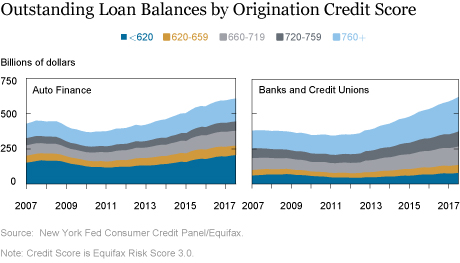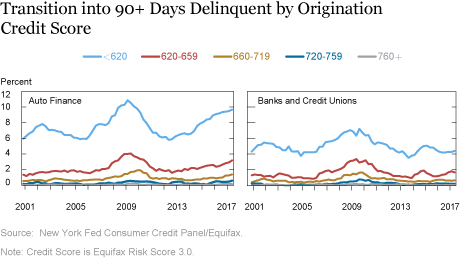Total household debt increased by $116 billion to reach $12.96 trillion in the third quarter of 2017, according to the latest Quarterly Report on Household Debt and Credit released today by the New York Fed’s Center for Microeconomic Data. Household debt has been growing since mid-2013, boosted in part by steady growth in auto loan balances, which have grown for twenty-six consecutive quarters thanks to record-high levels of newly originated loans. Although new vehicle sales had begun to slump over the summer after several strong years of growth, September and October saw a rebound in sales, ending with over 18 million vehicles sold (seasonally adjusted at an annualized rate), and auto loan originations in the third quarter were commensurate with these numbers. In this post, we revisit the state of auto lending and auto loan performance, using the New York Fed Consumer Credit Panel which is based on Equifax credit data.
Originations
We reported one year ago that amid high levels of originations to subprime borrowers, subprime balances had been growing quickly, and these trends have mostly continued. We have noted in an earlier blog post that one feature of our data set is that it enables us to infer whether auto loans were made by a bank or credit union, or by an auto finance company (typically made through a car manufacturer or dealer using Equifax’s lender classification). Subprime auto lending has long been dominated by auto finance companies, which have historically originated and held more than 70 percent of subprime auto loans. The chart below, which depicts newly originated auto loan balances for the two lender categories by borrowers’ credit score at the time of origination, shows that these trends have continued. Lending to borrowers with lower credit scores has not increased as rapidly in the past year as it had in the preceding years, while lending to borrowers with higher credit scores has continued apace.

Outstanding Balances
Outstanding subprime auto debt (classified in the chart below as debt held by borrowers with origination credit scores under 620) now stands at about $300 billion. Although this amount has increased steadily in absolute terms, as a share of the total outstanding auto loan balance, it has been fairly steady at around 24 percent since about 2011. Subprime loans are disproportionately originated by auto finance companies, and their share has nearly doubled since 2011 and now stands at over $200 billion—represented in dark blue on the left panel of the chart below. In comparison, the outstanding balances of bank auto loans remain dominated by loans originated to borrowers with higher credit scores, as shown in the right panel below.

Delinquency
Since 2011, the overall delinquency rate of loans originated by auto finance companies has significantly deteriorated. When we split the delinquency rate between auto finance and bank loans in the chart below we see that the 90+ day delinquency rate for bank auto loans has been steadily improving since the financial crisis. In contrast, the delinquency rate for auto finance companies has been sharply increasing since 2014, by more than 2 percentage points.
Further disaggregating the delinquency rates by the origination credit score of the borrower shows that while the delinquency rates for borrowers with credit scores of 660 or higher appear to be somewhat steady, the subprime delinquency rates are really where the pressure is. This is especially stark when we break out auto finance and bank loans, which shows that the delinquency rate – even among borrowers in the same credit score bucket – is considerably higher and rising on the auto finance side. This suggests that bank auto loans may have some additional layers of underwriting – credit score alone does not explain the gap and divergence in the delinquency rates. The overall delinquency rate for auto loans—published in our Quarterly Report—shows only a very slow increase masking the sharp rise in subprime delinquency, which is diluted by the increase in prime loans with better performance.

Although the impact on the larger financial sector may be muted, there are over 23 million consumers who hold subprime auto loans. These consumers may find their credit reports further damaged after a default or encounter further financial difficulties after experiencing a car repossession. This is an area of household debt we have been monitoring for some time now, and will continue to monitor.
Disclaimer
The views expressed in this post are those of the authors and do not necessarily reflect the position of the Federal Reserve Bank of New York or the Federal Reserve System. Any errors or omissions are the responsibility of the authors.
 Andrew F. Haughwout is a senior vice president in the Federal Reserve Bank of New York’s Research and Statistics Group.
Andrew F. Haughwout is a senior vice president in the Federal Reserve Bank of New York’s Research and Statistics Group.
 Donghoon Lee is an officer in the Bank’s Research and Statistics Group.
Donghoon Lee is an officer in the Bank’s Research and Statistics Group.
 Joelle Scally is the administrator of the Center for Microeconomic Data in the Bank’s Research and Statistics Group.
Joelle Scally is the administrator of the Center for Microeconomic Data in the Bank’s Research and Statistics Group.
 Wilbert van der Klaauw is a senior vice president in the Bank’s Research and Statistics Group
Wilbert van der Klaauw is a senior vice president in the Bank’s Research and Statistics Group
How to cite this blog post:
Andrew F. Haughwout, Donghoon Lee, Joelle Scally, and Wilbert van der Klaauw, “Just Released: Auto Lending Keeps Pace as Delinquencies Mount in Auto Finance Sector,” Federal Reserve Bank of New York Liberty Street Economics (blog), November 14, 2017, http://libertystreeteconomics.newyorkfed.org/2017/11/just-released-auto-lending-keeps-pace-as-delinquencies-mount-in-auto-finance-sector.html.











 RSS Feed
RSS Feed Follow Liberty Street Economics
Follow Liberty Street Economics
Mary: Thanks for the comment and suggestion – we have been monitoring student and auto loans for some time but have not formally investigated the role of securitization directly. While securitization plays a role in auto loan issuance, student loans are predominantly issued (and guaranteed) by the federal government, with private loans issuance being mostly restricted to borrowers with high credit scores.
Thank you, Liberty Street, for this blog on auto loans and also on student loans. I hope you will research and write about this topic: How much is the endless gush of money created by securitization responsible for over-borrowing, and how much is it responsible for rising prices (higher college costs, higher car costs)? I’m old enough to remember the old saying, “You can’t get a bank loan unless you don’t need one.” How different things are today. Thank you. Mary